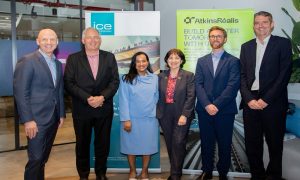VTT electric kiln advances environmentally friendly cement and paper production
Powered by low-emission electricity, the kiln also enables capturing of pure CO2 when lime is burned in the precalcination phase of cement production

The successful completion of several experiments with different feedstocks of its electrically heated rotary kiln will revolutionise the cement, quicklime and pulp production industries, VTT Technical Research Centre of Finland (VTT) has said.
The firm pointed out that cement and quicklime production causes significant emissions for two key reasons: the process requires a temperature of about 1,000-degrees Celsius, which means that emissions are released into the atmosphere when fuel is burned to create such high temperatures; second, as limestone – the main raw material of cement and quicklime – is heated, its carbonate decomposes into carbon dioxide, causing further emissions.
The production of carbon-neutral industrial-quality burnt lime mix has been an elusive goal until now, the firm said, while adding that finding a solution is a top global priority. The firm pointed out that its experiments were done between November 2021 and October 2022.
In early October 2022, Betolar unveiled its first India-made low carbon concrete products.

“Limestone is one of the most used raw materials in the world, so it is urgent we find ways to use it in a more environmentally friendly way. At VTT, we have been able to make the crucial calcination phase more sustainable. With tests of our electric kiln, we have proven that replacing combustion processes with electricity-based solutions is an effective means of curbing climate change. Furthermore, the quality of the burnt lime product is good,” said Eemeli Tsupari, Principal Scientist at VTT.
The captured CO2 can also be used for industrial purposes, from synthetic fuels to novel materials, like plastic replacements. It can also be permanently trapped, if mixed into concrete used for sidewalks, roads and bridges, VTT stated.
The pilot kiln is said to have been designed with convenient transportation in mind. When housed inside a cargo container, it can be easily transported to industrial plants, and used in different production processes, including chemical pulping in the paper industry.
In mid-October 2022, four cement factories said they would use alternative fuels following a deal with MOCCAE and Emirates RDF.

Tsupari added, “With proof of concept for the electric kiln in the pre-calcination phase, we are on the path towards fully decarbonising the second burn process by considering new carbon-free heat sources, such as hydrogen, to reach the necessary temperatures.”
The current global energy crisis has made electricity an even more desirable source of energy due to the high prices of fossil fuels. He continued, “The current high cost of natural gas makes electricity a more viable option for heating processes than gas. Solving this challenge globally could be the equivalent of taking millions of cars off the roads each year. We are now looking for partnerships with major industrial players to take this solution to the next level.”
Finnish cement supplier, Finnsementti, and Nordkalk, a manufacturer of limestone-based products, also participated in the test process.
In early November 2022, Dar Al Arkan said it had completed Saudi Arabia’s first 3DCP villa.

“The raw meal of cement production was successfully treated in the trial runs to an intermediate product, which is fully calcined but not yet reacted with silica, which is exactly what we want a calciner to achieve,” Mathias Frankenhaeuser, Technical Manager at Finnsementti commented.
Erkka Uuttu, Energy Manager at Nordkalk remarked, “It’s exciting to see that properties of calcium oxide produced in the best experiment points are very near to product-grade burnt lime.”
The kiln is located at a VTT facility in Central Finland in the city of Jyväskylä. Tsupari concluded, “Next, we would love to find a technology partner to help us build a large kiln to scale the output.”
In late November 2022, GUtech 3D said it printed three structures in eight days in Oman.
























